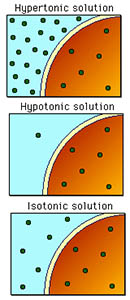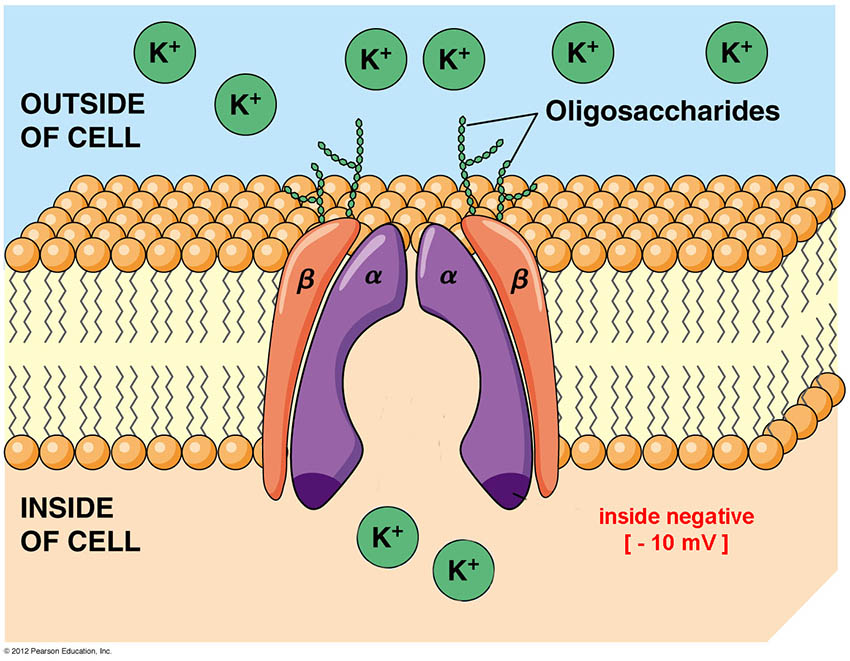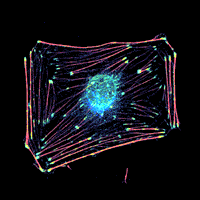How Things Get
In/Out of Cells The Cell Membrane*...
Unit Membrane Hypothesis:
EM plasma
cell membrane*
photomicrographs:
all
membranes look alike*
Two Ways to Study Membranes & Transport of
Solutes Across Membranes
a. NATURE OF
MEMBRANE ITSELF - "its Molecular Makeup"
b. PERMEABILITY
STUDIES
- "Physiological Properties of
Membranes"
a. need a source of membranes for study (plasma membrane -
RBC ghosts)
RBC-color*
and RBC ghosts*


-
a. Current Molecular Model of
Membrane Structure -
-
Fluid Mosaic model... has 2 major molecular
components
1. lipids
= Phospholipid
structure (C11video tab)
phospholipids*
and their
their
distribution*
-
lipids
spontaneously form bilayers via
hydrophobic effect*
lipid fluidity -
viscous vs. fluid (saturation vs.
unsaturation)*
see
fluidity video (C11)
exoplasmic
vs. cytoplasmic lipid differences*
-
2. proteins
- a)
Integral
(intrinsic)
proteins - part
of... & denatured upon release from...
b) Peripheral
(extrinsic)
- easily
extractable from membrane
fig 7.3
(locale)
- How proteins are embed in membranes*
-
-
Fluid Mosaic model* - extra-cellular matrix* glycoproteins*
-
- roles of membrane
proteins*view@home
&
functions*
-
membranes result in
compartmentation
a historical look
at membrane structures

b. Physiological Properties of
Membranes
Membrane
are selective permeable*
and membranes are mostly lipid, thus-
- transport is based upon lipid solubility (more
lipid soluble greater the transport)
-
- Partition
Coefficient ( lipid
solubility) vs.
Permeability
- an ideal graph* & actual
data --> molecular move thru
bilayer*
-
-
-
Movement of
Water... is an anomaly
-
polar, not
lipid soluble, yet readily permeable...
How?
1. Bulk flow...
hydrodynamics or mass flow of water is due to
-
potential energy of water (as in
rivers
& rapids via
gravity)....
-
Water potential is the chemical-energy
potential of water
& is a measure of energy available for
reactions or movement.
Water potential
measures the ability
of water to "move" in a system.
"Water
always moves from areas of High Water Potential (pure
water)
to an
area of Low Water Potential (diluted water)".

-
-
-
-
-
-
-
-
-
-
-
-
-
- 2. OSMOSIS - net
movement of water from
[High Water Potential] ---> [Low WP]
energy is not required: passive transport
has no energy requirement
osmosis*
| SOLUTIONS - we can
compare one solution
to another
solution |
|
hypertonic
solution
= "more solute, less
water" (hyperosmotic)
hypotonic
solution
= "less solute, more water"
(hypoosmotic)
isotonic solution
= "equal solute and
water"
(isosmotic)
Cells & Solutions -
Plants & Animals balance
water & solutes via:
tonicity*
state of water moving into or out of
a cell by osmosis
osmolarity*
describes both solute and water
concentrations
plasmolysis*
loss
of cytoplasmic structure due to water
loss
turgidity
swollen cells
due to water gains |

|
|
animation example of
various osmotic situationsview@home [4.5 min] |
|
AQUAPORINS* - Discovery of Water
Channel proteins
2003 Nobel Prize in Chemistry
-

-
-
-
-
-
-
-
-
-
-
-
-
How
Things
(solutes = molecules) Get Across a Membrane
[4 Ways]
1.
through a
PORE*... made by proteins
embedded in bilayers*
allows
ions & small hydrophilics to move
through the pore.-
-
2. by DISSOLVING
in*
membrane... hydrophobic solutes via
lipid bilayer
-
-
3. by CHANNEL
and CARRIER PROTEINS* ...
proteins embedded in membrane w specificity for a solute
results in transport of solute through the
protein by diffusion
-
4. by
membranes ENGULFING particles* into membrane vesicles...
ENDOCYTOSIS - phagocytosis
(forms a phagosome - vesicle w solids)
&
pinocytosis (forms a
liquid vesicle)
EXOCYTOSIS - exports
vesicle contents via the endocytotic
pathway
- constitutive vs. regulated
exocytosis.

Solute Transport across
Membranes...
Animation of diffusion* -
DIFFUSION*
A.
net thermal motion of solute down a concentration
and/or electrical
gradient
- solutes
move from area of higher
to area of lower
concentration
- thus, diffusion requires no
expenditure of cellular energy
B. Carrier
Mediated Transport...
animation*
Facilitated
Diffusion* may be thru a channel or carrier protein...
ex:
Glucose
Transport*
defined
as protein mediated passive
transport facilitated
either by channel
proteins or carrier
proteins.
C. Diffusion is PASSIVE*
transport.
D. The rate of diffusion is directly
proportional to the concentration gradient:
simple diffusion = (Δn/Δt) = [C]
&
faciltated diffusion = graph*

What
about IONS
with their
+/-
charges and an electrical gradient
?
Ion
transport is the movement of ions across
a membrane by a tranporter, a
transmembrane protein,
either passively or actively through ion pumps,
such as symporters and
antiporters.
ex: Potassium ions
transport video (C12) is through ion channels*
Will a charged ion [Na+or
K+
] behave differently when there is not only a
Chemical
Gradient, but also an Electrical Gradient*
across a membrane ?

to answer this questions we can use the....
Nernst Equation which defines PASSIVE Electrochemical
Equilibrium by
determining mathematically what the electrical
potential (charge should be)
across a cell based on the existing PASSIVE distribution of
ions...
E(mV) = (+/-) 62
log10 [Co/Ci] Nernst equation for
Na+*

ACTIVE
TRANSPORT - cells expend energy
(often via...
hydrolysis of ATP)
to move a solute against a
concentration
gradient-
animal cells - NaK-ATPase
animation* ---> Na-Pump*
ex: sodium pump
(C12)
lysosomes-
a Proton Pump
---> H+-ATPase*
-
ex: Bactriorhodopsin
- H+-pump (C11)
pumps are ELECTROGENIC...
move charge one
way =
voltage
CO-TRANSPORT...
movement of 2 solutes
together -
often moves 1 solute passively (down) & other actively (up gradient)
ex: 1) H+pump
coupled to sucrose
transport via a H+symport* system
2) epithelial cotransport model
[animation*]
ex: Na-glucose symport
video (C12) - Na+/glucose* transport
- CHEMICAL
TRANSPORT... of Cationic Peptide Drugs
Researchers at U.Breman have developed
chemical carriers (COSANs) with
hydrophobic
properties that when sandwiched with cationic
peptides can facilitate the selective
transport, while preventing the peptide
degradation and achieving efficient delivery
at
desired locations.
- _______________________________________________________
definitions:
uniport
- single solute in one direction
symport - 2 solutes
simultaneously in same direction
antiport* - 1 solute in &
1 solute out -opposite directions
-
-
 Transport
Carriers video (C12)
Transport
Carriers video (C12)
Examples of Carrier
transport*
Summary of passive vs active transport*
______________________________________________________
-
-
-
-
Exocytosis
- releases (OUT)
bulk material to outside...
fig
7.9 - secretory vesicles*
Endocytosis ...
takes IN solutes/particles
by
vesicles
view
anim's@home
-
- phagocytosis* - solid
particle uptake into phagosome vesicle
- animation
-
-
pinocytosis*
- liquid uptake into pinocytotic vesicle
-
animation
-
- receptor mediated*endocytosis - uptake via membrane receptors
- animation
-
- coated pits with protein clathrin
both
-
 Key Concepts*
animation
of inner Life of Cell - Key Concepts*
animation
of inner Life of Cell -
 view @ home view @ home
next lecture
copyright c2023
Last update - October 2024
Charles
Mallery,
Department of
Biology, U. of Miami, Coral
Gables, FL 33124
Wiley Publishing animation of membrane transport
*view@home
Mathematical
Models for Simple Diffusion & Facilitated
Diffusion.
|


